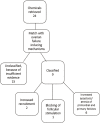A critical analysis of the impact of endocrine disruptors as a possible etiology of primary ovarian insufficiency
- PMID: 32202399
- PMCID: PMC7365523
- DOI: 10.5935/1518-0557.20200005
A critical analysis of the impact of endocrine disruptors as a possible etiology of primary ovarian insufficiency
Abstract
Primary ovarian insufficiency is a cause of infertility that affects about 1% of women under 40 years old, and is considered as idiopathic in 75% of cases. This review aims to carry out a critical synthesis of the knowledge of the chemical agents likely to affect follicular stock in humans and / or animals, by direct toxicity to follicles, or by increasing their recruitments. For the majority of toxic agents, only experimental data are currently available. We propose a strategy to encourage progress in identifying occupational factors responsible for premature ovarian failure.
Keywords: Endocrine disruptor; Follicular atresia; Occupational exposure; Primary ovarian insufficiency.
Conflict of interest statement
The authors have no conflict of interest to declare.
Figures
References
-
- Carvalho LVB, Costa-Amaral IC, Mattos RCOC, Larentis AL. Exposição ocupacional a substâncias químicas, fatores socioeconômicos e Saúde do Trabalhador: uma visão integrada. Saúde Debate. 2017;41:313–326. doi: 10.1590/0103-11042017s226. - DOI
-
- Hauser R, Gaskins AJ, Souter I, Smith KW, Dodge LE, Ehrlich S, Meeker JD, Calafat AM, Williams PL, EARTH Study Team Urinary Phthalate Metabolite Concentrations and Reproductive Outcomes among Women Undergoing in Vitro Fertilization: Results from the EARTH Study. Environ Health Perspect. 2016;124:831–839. doi: 10.1289/ehp.1509760. - DOI - PMC - PubMed
Publication types
MeSH terms
Substances
LinkOut - more resources
Full Text Sources
Medical




